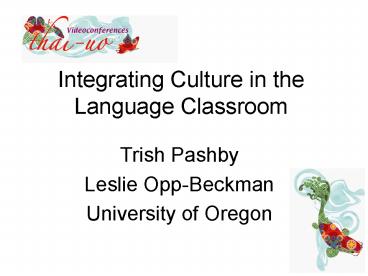Integrating Culture in the Language Classroom - PowerPoint PPT Presentation
1 / 25
Title:
Integrating Culture in the Language Classroom
Description:
Teacher Challenges. Limited preparation time. Access to practical activities. ... photos, anecdotes, guest speakers, souvenirs... Cultural Texture. Activity ... – PowerPoint PPT presentation
Number of Views:70
Avg rating:3.0/5.0
Title: Integrating Culture in the Language Classroom
1
Integrating Culture in the Language Classroom
- Trish Pashby
- Leslie Opp-Beckman
- University of Oregon
2
Topics, Session 08
- Announcements
- Overview
- Activity 1 Brainstorm
- Part I What is Culture?
- Part II Culture in the Class
- Activity 2 Network Tree
- Conclusion, Q A
3
Announcements
- Introductions
- Continuing the series, starting November
2005http//thaiuo.uoregon.edu/ - Homework to share?
4
Activity 1
- Brainstorm, Graphic Organizers,
- Network Tree
- Work in groups. Choose a unit or theme from your
text andlist as many matching cultural topics
as you can.
5
(No Transcript)
6
What is Culture?
- Culture is the shared beliefs, symbols, and
interpretations within a human group...The
essence of a culture is not its artifacts, tools,
or other tangible cultural elements but how the
members of the group interpret, use, and
perceive them. (Banks, 2001)
7
Characteristics of Culture
- It is
- Learned
- Transmissible
- Dynamic
- Selective(Porter and Samovar, 1994)
8
Characteristics of Culture
- Culture shifts in and outside our reflective
awareness. - (Erikson, 2001)
9
4 Areas of Culture
- Aesthetic
- Sociological
- Semantic
- Pragmatic/Sociolinguistic
- (Lessard-Clouston, 1997)
10
Bangkok Islamic School, iEARN
11
Bangkok Islamic School, iEARN
12
Bangkok Islamic School, iEARN
13
International Education and Resource Network
(iEARN) Teddy Bear and over 200 Other
Cross-Cultural Projectshttp//www.iearn.org/
14
Culture and Communication
- are inseparable because culturehelps to
determine how people encode messages, their
meaning for messages, and the conditions and
circumstances under which messages may or may
not be sent, noticed, or interpreted. (Samovar,
Porter, Jain, 1981)
15
Intercultural Understanding
- It is insufficient to promote the use of English
as a mere linguistic tool. Rather, its function
as a means for intercultural understanding and
communication should be further expandedinto one
that incorporates intercultural awareness
understanding as well. (Kim, J., 2002)
16
Benefits to Students
- Students benefit most when our culture lessons
and the cultural aspects of our language teaching
are well planned and developed. - (Lessard-Clouston, 1997)
17
Goals
- We must help students
- Gain knowledge of the target language culture.
- Develop skills in communication and behavior in
the target language. - Become aware of dynamic nature of all cultures.
18
Teacher Challenges
- Limited preparation time.
- Access to practical activities.(Omaggio in
Cullen, 2000) - Lack of cultural insight.
- Lack of sources of information. (Kim, J., 2002)
19
Ethnographic Approach
- Teachers and students can become ethnographers
and explore their own beliefs about the target
language and their native language. This
experience can be used as the basis for
cross-cultural application and analysis.
20
Cultural Texture
- Information Sources
- Video, CDs, TV
- Readings, internet, stories, songs, newspapers,
realia - Fieldwork, interviews, photos, anecdotes, guest
speakers, souvenirs
21
Cultural Texture
- Activity Types
- Quizzes
- Action logs
- Reformulation, noticing, prediction
- Research
22
Cultural Texture
- Selling-points (contrasting views)
- Historical vs. modern, older vs. younger
generations - City vs. country life
- Stated beliefs vs. actual behavior similarities
vs. differences
23
Activity 2
- Cultural Texture (Cullen)
- Match Content from Activity 1 to
- Information sources
- Activity types
- Selling points (contrasting views)
- What Cultural Texture items did your group
choose, and why?
24
Practical Tips
- Personalize content.
- Vary activities.
- Use suitable level of difficulty.
- Choose high interest topics.
- Use group work.
- Dont try to cover everything. (Cullen, 2000)
25
Integrating Culture in the Language Classroom
- http//thaiuo.uoregon.edu
- Trish PashbyLeslie Opp-BeckmanUniversity of
Oregon































